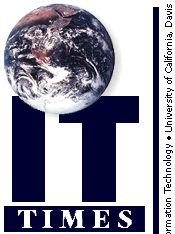
Virtual Lectures: The Course of the Future?
by Harry Matthews, Biological Chemistry"You could pause at slides that you needed a little time to muse over and skip over those that you felt you already had a good grasp of," [1] said a student evaluating a course delivered by computer at UC Davis. Last quarter, for 100 medical students, 23 virtual lectures replaced 23 physical lectures. Available on 5 CDs, these multimedia teaching materials were the primary source of course content for BCM 410A, a required first year medical student course in molecular and cellular biology. Each lecture is based on animated computer graphics that are very effective in explaining the concepts of protein molecular biology.
Over the last 15 years, these lectures -- in their physical form -- have followed a steady progression from blackboard to overheads and slides to multimedia to oblivion.
At UC Davis, there are some brilliant lecturers who should never stop lecturing and don't need multimedia props. But what about "ordinary mortals" whose best efforts to excite and enthrall students meet with limited success? Can the computer do a better job?

Is the virtual lecture the course of the future -- delivered by computer and controlled by the student? Another student thought so: "This is definitely something that should continue to be implemented in the future." [2]
Overall, the students in BCM410A valued the ability to choose the pace of the lecture, the schedule and the location. [3] The success of the interactive virtual lecture (see figure) already has important implications for teaching spaces, network infrastructure, resource sharing and distance education.
This is a period of rapid change. I don't see undergraduate education improving in the face of increasing class sizes unless the process changes dramatically. Mass production is not the answer to higher education's problems. But mass customization might help. Today's virtual lectures already provide a unique experience for each student. Students explore the material at their own pace and the order of their choosing. Different students will check different glossary entries and tutorials. The "lectures" will evolve with increasingly sophisticated interaction between the student and the computer. The computer will "understand" and respond appropriately to an increasing number of questions and will adapt to each student's learning pace and style. We already have adaptive examinations -- it is time we exploited this technology for learning.
Once the computer takes the burden of content delivery and the learning of basic intellectual skills, the professor can return to interacting personally with students in groups of less than 10 with sharp focus on skills and attitudes. This was done as a companion to the virtual lectures last quarter and as a student said, of the small groups: "The process of 'bouncing ideas' off each other is a great learning tool in itself" [4] and, best of all, "They were fun, good to wake up to." [5]
Author's Notes:
-
1 Quoted from midterm evaluation #5 for BCM410A, 1997.
2 Quoted from midterm evaluation #80 for BCM410A, 1997.
3 The main disadvantage was lack of speedy response even using a local CD-ROM drive. The lectures are designed for delivery over the Web but there is inadequate bandwidth for this. To completely refresh a 21" computer screen 30 times a second with 24-bit color needs 1.4 billion bits/second. Maybe something like this will be the future unit of network speed, i.e., 1 user unit (UU) = 1 billion bits/sec. I know compression will reduce this load, but the need for interactivity and sound will increase it again.
For more information:
- Matthews' Web site:
- http:/trc.ucdavis.edu/HRM
- Description of Virtual Lectures:
- http://trc.ucdavis.edu/coursepages/bcm410a/virtual.html
- Sample of Virtual Lecture:
- http://trc.ucdavis.edu/coursepages/bcm410a/sample.html
Harry Matthews is professor of biological chemistry.